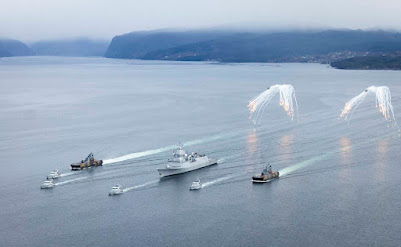The Royal Navy’s Wildcat maritime attack helicopters have demonstrated their ability to hunt down and engage enemy forces during a game of cat and mouse in the Norwegian fjords.
Yeovilton-based 815 Naval Air Squadron have been exercising with four of the Royal Navy’s P2000 patrol ships, two Norwegian corvettes and frigate HNoMS Roald Amundsen off Bergen, in one of the world’s most challenging environments, for Exercise Tamber Shield.
Alongside the P2000s, the Wildcats were tasked with finding and targeting the Skjold-class corvettes amongst the many inlets and narrow waterways of the fjords.
In one particular scenario, HMS Biter and HMS Exploit, part of the Royal Navy’s Coastal Forces Squadron, headed north from Bergen, while fellow P2000s HMS Trumpeter and HMS Blazer headed south to use their skills and expertise to locate the Norwegian vessels before relaying that information to 815 NAS who were charged with making simulated attacks.
Capable of 60 knots, the Skjolds are fast and agile – using their camouflage to blend into the landscape, which their crew knows like the back of their hand.
However, aircrew from 815 NAS were more than up for the challenge, employing newly developed tactics to fend off the fast attack craft threat.
 Lieutenant Maxwell Randles-Hall, an 815 NAS Observer, said: “The Norwegian Fjords present a challenging and unforgiving operating area for aircraft.
Lieutenant Maxwell Randles-Hall, an 815 NAS Observer, said: “The Norwegian Fjords present a challenging and unforgiving operating area for aircraft.“As a result, Wildcat crews must effectively employ every sensor and system to succeed in their mission and evade attack.
“The topography gifts a significant advantage to the opposition forces, played by the P2000s and Skolds, so crews must think extremely carefully about their every move, working as a team to methodically neutralise targets.”
Operating as part of the Joint Expeditionary Force – a group of like-minded nations led by the UK – Exercise Tamber Shield provides extremely valuable training for the crews of the P2000s.
Made up of nations including the UK, Norway, Denmark, Finland, Estonia, Iceland, Latvia, Lithuania, the Netherlands and Sweden, the JEF reacts to events in northern Europe’s waters, ready to respond to crises and world events.

